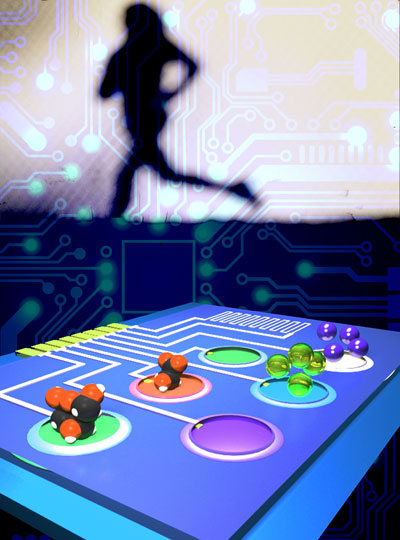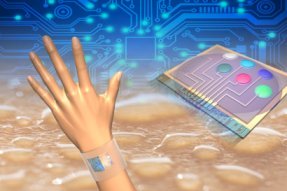Specifically, it is for a flexible sensor system that can measure metabolites and electrolytes in sweat, calibrate the data based upon skin temperature and sync the results in real time to a smartphone.
 While health monitors have exploded onto the consumer electronics scene over the past decade, researchers say this device, reported in the Jan. 28 issue of the journal Nature, is the first fully integrated electronic system that can provide continuous,
While health monitors have exploded onto the consumer electronics scene over the past decade, researchers say this device, reported in the Jan. 28 issue of the journal Nature, is the first fully integrated electronic system that can provide continuous,
The advance opens doors to wearable devices that alert users to health problems such as fatigue, dehydration and dangerously high body temperatures.
«Human sweat contains physiologically rich information, thus making it an attractive body fluid for
Javey worked with study
Chemical clues to a person’s physical condition
To help design the sweat sensor system, Javey and his team consulted exercise physiologist George Brooks, a UC Berkeley professor of integrative biology. Brooks said he was impressed when Javey and his team first approached him about the sensor.
 «Having a wearable sweat sensor is really incredible because the metabolites and electrolytes measured by the Javey device are vitally important for the health and
«Having a wearable sweat sensor is really incredible because the metabolites and electrolytes measured by the Javey device are vitally important for the health and
The prototype developed by Javey and his research team packs five sensors onto a flexible circuit board. The sensors measure the metabolites glucose and lactate, the electrolytes sodium and potassium, and skin temperature.
«The integrated system allows us to use the measured skin temperature to calibrate and adjust the readings of other sensors in real time," said Gao. «This is important because the response of glucose and lactate sensors can be greatly influenced by temperature.»
Developing smart wristbands and headbands
Adjacent to the sensor array is the wireless printed circuit board with
 They put the device — and dozens of volunteers — through various indoor and outdoor exercises. Study subjects cycled on stationary bikes or ran outdoors on tracks and trails from a few minutes to more than an hour.
They put the device — and dozens of volunteers — through various indoor and outdoor exercises. Study subjects cycled on stationary bikes or ran outdoors on tracks and trails from a few minutes to more than an hour.
«We can easily shrink this device by integrating all the circuit functionalities into a single chip," said Emaminejad. «The number of biochemicals we target can also be ramped up so we can measure a lot of things at once. That makes
Javey noted that a
Brooks also noted the potential for the device to be used to measure more than perspiration.
«While Professor Javey’s wearable,
The Berkeley Sensor and Actuator Center and the National Institutes of Health helped support this work.
Source: http://news.berkeley.edu/2016/01/27/wearable-sweat-sensors/

